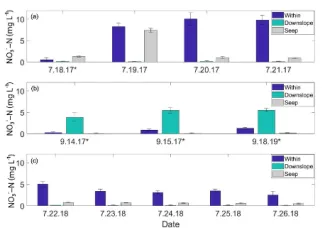In Arctic ecosystems, warming temperatures have been associated with the expansion of shrubs across tundra landscapes. The proliferation of shrubs can change the local soil chemistry, especially if the shrub species can partner with symbiotic microbes that fix “unavailable” nitrogen from the atmosphere into a biologically available form. To better understand spatial and temporal variation of nitrate across an arctic hillslope site, McCaully et al. (2022) sampled porewater at locations upslope, within, and downslope of shrublands dominated by nitrogen-fixing alder (Alnus viridis spp. fruticosa). Samples were collected during three field campaigns under a variety of weather conditions. Overall, we found that soil pore water from underneath alder shrublands had significantly higher levels of nitrate than areas outside the shrubland (4.27±8.02 mg N L-1 versus 0.23±0.83 mg N L-1; p<0.05). Following precipitation events, elevated nitrate levels were found in samples collected from tussock tundra located downslope from alder shrublands, indicating that nitrate had been flushed downhill by the rain (See Figure). In these, wet, downslope locations, enriched δ15N and δ18O suggested that denitrification buffered the mobility and spatial extent of nitrate. Since alder shrublands have been expanding at this hillslope site since the 1950’s (Salmon et al., 2019), these findings highlight how changing climate and vegetation together can alter the spatial and temporal patterns of nitrogen availability across an otherwise infertile arctic landscape.
Citation: McCaully RE, CA Arendt, BD Newman, VG Salmon, JM Heikoop, CJ Wilson, S Sevanto, NA Wales, GB Perkins, OC Marina, and SD Wullschleger (2022). High nitrate variability on an Alaskan permafrost hillslope dominated by alder shrubs. The Cryosphere 16: 1889–1901. https://doi.org/10.5194/tc-16-1889-2022
Reference: Salmon VG, AL Breen, J Kumar, MJ Lara, PE Thornton, SD Wullschleger, and CM Iversen (2019). Alder Distribution and Expansion Across a Tundra Hillslope: Implications for Local N Cycling. Frontiers in Plant Science 10: 1–15. https://doi.org/10.3389/fpls.2019.01099
For more information, please contact:
Carli Arendt
carendt@ncsu.edu

